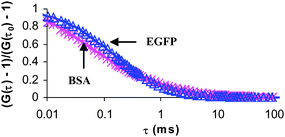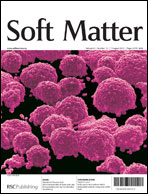Controlled diffusion and release of soluble molecules is one of the key challenges in developing three-dimensional (3D) scaffolds for tissue engineering and drug delivery applications in part because current methods to measure dynamic transport properties are difficult to perform directly, are strongly affected by the experimental setup, and therefore can be a subject to various artifacts. In this work we present a method for direct measurement of translational diffusion of solutes, namely Fluorescence Correlation Spectroscopy (FCS), by characterizing the diffusion of model proteins through a 3D cross-linked poly(ethylene glycol) (PEG) hydrogel scaffold. We examined both the dynamics of hydrogel structure (e.g., cross-linking and swelling) as well as protein size and their effect on protein diffusivity. For example, we demonstrated that protein diffusivity was closely related to protein size as smaller proteins (e.g., lysozyme) diffused faster than larger proteins (e.g., γ-globulin or Ig). We validated the FCS protein diffusivity results by comparison to standard bulk diffusion assays. Additionally, due to the nature of FCS measurements, we were able to probe for hydrogel–protein interactions during cross-linking that may contribute to the obstructed protein diffusion in the 3D scaffold. We determined that such interactions in this system were not covalent (i.e., were independent of the cross-linking chemistry) but may be due to weaker hydrogen bonding or ionic interactions. Also, these interactions were protein specific and contributed up to 25% of the total decrease in protein diffusivity in the hydrogel as compared to diffusivity in water. Though interactions between various proteins and PEG have been reported, this is the first study that has explored these effects in detail in cross-linked PEG hydrogels using FCS; our findings question the assumption that PEG hydrogels are completely inert to protein interactions when applied as drug delivery matrices and tissue engineering scaffolds.

You have access to this article
 Please wait while we load your content...
Something went wrong. Try again?
Please wait while we load your content...
Something went wrong. Try again?


 Please wait while we load your content...
Please wait while we load your content...